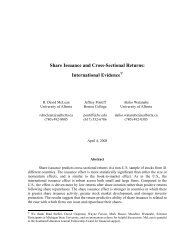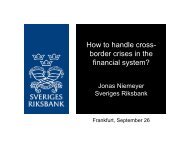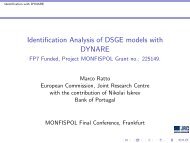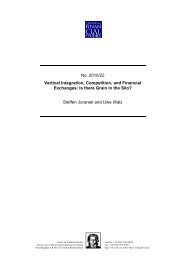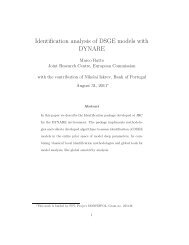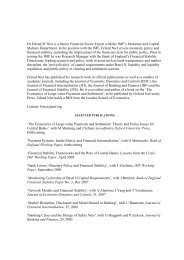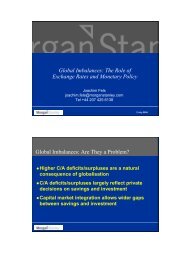Forecasting and Policy Making (Paper) - Center for Financial Studies
Forecasting and Policy Making (Paper) - Center for Financial Studies
Forecasting and Policy Making (Paper) - Center for Financial Studies
You also want an ePaper? Increase the reach of your titles
YUMPU automatically turns print PDFs into web optimized ePapers that Google loves.
Table 8: State Space Representation <strong>and</strong> Model Equations<br />
structural parameters θ = (β,τ,ρg,ρz,γ,r ∗ ,π ∗ ,κ,ρR,ψ1,ψ2,σR,σg,σz)<br />
observable variables y obs<br />
t = [ Y GRt INFLt INTt ] ′<br />
steady state y(θ) = [ 0 ln π ∗ ln r ∗ + ln π ∗ ] ′<br />
deterministic trend λ = [ ln γ 0 0 ] ′<br />
subset of endogenous<br />
variables<br />
y s t = [ ∆xt + zt πt Rt ] ′<br />
endogenous variables yt = [ xt Rt πt gt zt ] ′<br />
shocks ut = [ ǫR,t ǫz,t ǫg,t ] ′<br />
rules. Its parameters are given by the two solution matrices gy <strong>and</strong> gu which are nonlinear functions<br />
of the structural parameters θ. Thus, the transition equations relate the endogenous variables yt to<br />
lags of themselves <strong>and</strong> the vector of exogenous shocks ut. Since, the measurement equations include<br />
the deterministic growth path that is driven by labor-augmenting technological progress no separate<br />
de-trending of the data is necessary.<br />
Model Estimation<br />
DSGE models are often estimated using Bayesian estimation. Bayesian estimation combines<br />
the likelihood with prior beliefs obtained from economic theory, microeconomic data or previous<br />
macro studies. An extensive survey of the methodology is presented in An <strong>and</strong> Schorfheide<br />
(2007). Because the reduced-<strong>for</strong>m coefficients of the state-space representations are nonlinear<br />
functions of the structural parameters, θ, the calculation of the likelihood is not straight<strong>for</strong>ward.<br />
The Kalman filter is applied to the state space representation to set up the likelihood function<br />
(see e.g. Hamilton, 1994, chapter 13.4). Combining the likelihood with the priors yields the log<br />
posterior kernel lnL(θ|Y T ) + lnp(θ) that is maximized over θ using numerical methods so as to<br />
obtain the posterior mode. In principle the posterior mode can be used to generate point <strong>for</strong>ecasts<br />
directly. However, most authors simulate the whole posterior distribution of the parameters using the<br />
Metropolis-Hastings-Algorithm, compute density density <strong>for</strong>ecasts based on draws from the poste-<br />
rior distribution of the parameters. The mean of the density <strong>for</strong>ecast is usually used as a point <strong>for</strong>ecast.<br />
<strong>Forecasting</strong><br />
To compute <strong>for</strong>ecasts one can either estimate the model using the most recent available data vin-<br />
tage or combine earlier parameter estimates with the most recent data. In both cases the Kalman-Filter<br />
is applied to estimate the current state of the economy including all unobservable variables <strong>and</strong> shock<br />
38



